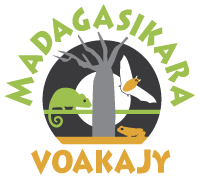It's a misty morning when we leave Moramanga for ten days of fieldwork in Mangabe, where we are setting up and promoting a new protected area. Humidity clearly reaches its peak at dawn, and I can barely recognize the shapes of the bigger buildings. The streets are already full of people and animals running around. The team going to Mangabe is quite large, and every couple of minutes the car stops to pick somebody new up. Soon I lose track of how many people are in the car, and of who's who. There are MV staff, people from the topographical and forest agencies of the government, representatives of local communities, mayors, a cook and who knows who else.
We leave the town behind, and we start driving through small country roads shrouded in mist. We pass men riding bikes, women with enormous bags of rice on their heads, and the usual, proverbial chicken crossing the road. On both sides of the road there's a thick bushland, the result of the constant deforestation that is plaguing Madagascar. We pass the burnt fields created by tavy – a traditional agricultural system based on overexploiting the soil and burning down the vegetation. Banana trees sprout every few meters.
We get to our first destination when it's not ten yet, and we set out camp up in a grassy field right next to a small village. The village really is tiny, just a few houses that make up one of the many communities scattered around Mangabe. Hills are not very steep, and terraces have been built so that they could be farmed. Everything is really green, and when the sun is shining they're almost beautiful – if you don't think about the forest that used to be there. We have our first meeting in the village church – a small building with white walls and a wooden roof. Local communities are involved in the creation process of the new protected area, so that they can express their concerns and avoid conflict. Locals need to know where are the borders of the reserve, and our main objective here is to mark them with the community representatives, recording the coordinates on a GPS.
The meeting is quite lively, as usual. Traditional land use rights are brought up: the topographical agency want to have some written proof of property, but here nobody has papers. Few people can actually write. They talk about conflict with the neighboring village – immigrants! And they want to manage our land! – but in the end everything seems to be working out fine.
Days are long here. We wake up early – at five I'm already up, reading a book in my sleeping bag. The tall grass pressed under my tent isolate it from the ground, and the night is not that cold – even if we're in the middle of the austral winter. Mornings are a bleak affair though, on this side of Mangabe. Hills are barely recognizable in the mist, and everything is covered in dew. The sky is grey and the light gives the landscape a dream-like quality. After a few hours the sun breaks the clouds, chasing the humidity away, and it gets warm enough to go to the river to wash up.
On our third day we move to our new campsite, a school on top of a little hill. Schools are used by more than one village, so they are usually built somewhere in the middle. The school building is warm and modern, and all around us the fields haven't been farmed for a while – giving trees the chance to start recolonizing the hills. I can't call it a forest – yet – but it's a start. I learn that the land belongs to another foreigner, a German man who moved here with his Malagasy wife thirteen years ago. I pay the couple a visit in their little épicerie, hoping to get some coffee. I end up having a couple of beers as well – the couple doesn't like speaking French, and they're happy to be able to speak English for a while.
Fed up with the German government, the vazaha left everything behind, and after travelling through Africa for a bit he settled down in this little corner of the world. He tells me it was the scariest thing he's ever done, but that the outcome was worth the sleepless nights. He bought some land, and started a plantation. He grows banana, papaya, and mango trees – and some fruit trees I've never seen before. There's a couple of geese in a pen, but no chicken – they destroy the garden, and their meat is so stringy anyway. There's chili and bell peppers – it's winter now, so they don't grow so well – potatoes, manioc, radishes, ginger and more. He planted cherry and apple trees, but he doesn't know if they'll be able to grow in this climate.
He gets his seeds from his mother, who is still in Germany, he tells me while we eat some pickled yellow string beans. Malagasy farmers don't have these varieties, so they come here to buy his produce. Everything is organic, and the Malagasy wonder how I'm still farming the same land after all this years. They don't want to learn, he goes on. They farm intensively for a few years, strip the soil of nutrients, and then they move somewhere else. And we're back to the same point, unsustainable agriculture and deforestation. This country desperately needs new ways to grow crops - but I have the feeling that in these years of political instability agriculture and land management are not very high in the "transition" government's "to do" list.
(to be continued)



